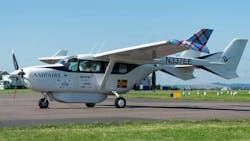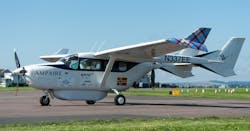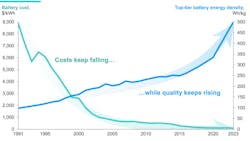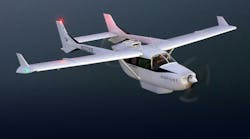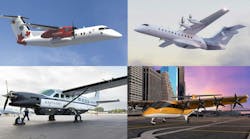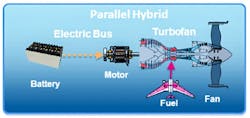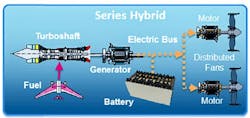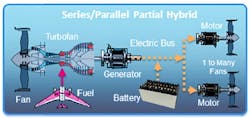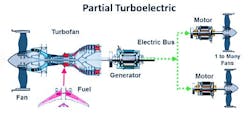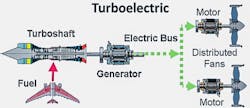An Introduction to Hybrid-Electric Aircraft (Part 2)
What you’ll learn:
- Powered by a combination of batteries and internal combustion, hybrid-electric aircraft can cut CO2 emissions by 50% or more along with offering dramatically lower operating costs.
- While the low power densities of today's batteries make all-electric flight impractical for most applications, hybrid-electric propulsion provides a practical alternative which also accelerates the development of the technologies which will enable pure electric flight.
- Several companies already have hybrid-powered commercial passenger aircraft under development, some of which should enter the market in the next few years.
As we learned in Part 1 of this series, electric propulsion holds significant potential for reducing aircraft carbon emissions while dramatically reducing operating costs.* It also became evident that pure electric flight is impractical for most applications at this time, mainly due to the relatively low power densities available from today's commercially available batteries (Fig. 1).
The good news is that, since battery technology is steadily improving (Fig. 2), all-electric flight could become commercially viable for some applications, such as small (6-10 passengers) short-haul (250-500 miles) commuter aircraft in five to 10 years.1,2,3 The less good news is that, barring an unforeseen breakthrough, it could take much longer for batteries with the power densities required for larger, faster aircraft with ranges of 1,000+ miles to enter production.
Although it may take close to 20 years before we see large, intercontinental all-electric airliners, several technologies will provide many of the benefits of electric propulsion much sooner. Referred to collectively as "hybrid propulsion" technologies, these new architectures employ several different combinations of battery-power and internal-combustion technologies to significantly reduce aircraft carbon emissions and operating costs.
Hybrid-electric propulsion promises to be a cost-effective "transitional" technology that will deliver substantial economic and environmental benefits for the next generation of aircraft. In addition, it will give airframe manufacturers the opportunity to develop many of the technologies, know-how, and manufacturing resources they need to achieve practical all-electric flight.
>>Download the PDF of this article, and check out the other parts of this series
Exploring the Hybrid Propulsion Continuum
Much like their ground-hugging EV cousins, electric aircraft can use one of several different types of hybrid propulsion architectures.
Hybrid Propulsion System: Parallel Configuration
In a parallel system, the ICE engine (typically a turbine) and the electric motor are both directly coupled to the propeller, enabling either unit to spin the prop or share the load between them (Fig. 3).1,4 This is somewhat analogous to the Integrated Motor Assist (IMA) system used by Honda in its early hybrid cars, where an electric motor/generator shared the drivetrain with the gasoline motor.
Much like its terrestrial cousins, a parallel system allows for a plane to be equipped with a smaller ICE engine, relying on its battery pack to provide the additional power needed for takeoff and sustained climb operations. This relatively simple configuration enables the ICE engine to drive the propeller as needed while using any surplus output to charge the plane's battery pack via the motor/generator. The battery pack can also be recharged using the equivalent of regenerative braking during descent.
Parallel hybrid propulsion systems can be implemented in several different ways, each described according to the position of the motor/generator in the drivetrain. Most commonly, they can be classified as double-shaft and single-shaft configurations with further sub-categorization according to the position of the motor/generator in the drivetrain. For example, Figure 4a illustrates the double-shaft parallel configuration, in which the engine and the motor/generator are mounted on two separate drive shafts.
If the engine is connected to the motor/generator but not directly linked to the propeller, the architecture is called single-shaft since the transmission has only one input shaft (Fig. 4b). Generally, the electric machine is directly linked to the propeller, while the engine is connected to the electric machine via decoupling devices and gears. In this architecture, the speed of motor/generators is always rigidly linked to that of the propeller.
While a basic parallel system offers many advantages, it also has the potential to suffer from inefficient operation. This is because the direct coupling forces the propeller's rotational speed to vary widely from the relatively narrow RPM band in which the ICE engine operates most efficiently.
Most of these inefficiencies can be overcome by adding a continuously variable transmission (CVT) to enable the engine and propeller to run at different speeds. This is somewhat analogous to the system used by Toyota in its Prius and other hybrid offerings.
Alternatively, some developers have chosen to save the weight and cost of a CVT by using a software-based management strategy that distributes the total load between the engine and the motor, allowing the engine to operate close to its optimal parameters. While somewhat less effective, it doesn't add much to the plane's weight or unit cost.
A closer look at the parallel hybrid architecture, including detailed descriptions of each of its operating modes, is available in the paper “Modeling and Simulation of a Parallel Hybrid-Electric Propulsion System,”4 published by researchers at Georgia Institute of Technology.
Hybrid Propulsion System: Series Configuration
In a series hybrid propulsion system, one or more propellers are connected directly to their own electric motor, with the ICE engine (usually a turbine) connected to an electrical generator that can be used to drive the motors and/or charge the battery pack (Fig. 5).1 This isn’t unlike some of the plug-in hybrid systems that are becoming popular in electrified cars and trucks.
One of this architecture's biggest advantages is that the engine is completely decoupled from the propeller, enabling it to run at its optimum parameters when needed, and shut down when conditions allow for operation on pure battery power. As a result, the ICE engines used in series systems enjoy high fuel efficiencies and longer service lives.
Although the series hybrid electric architecture tends to offer somewhat lower efficiency during ICE operation and adds some complexity (in the form of separate motor and generator units), it offers lots of flexibility and can be easily used to implement distributed (multi-engine) electric powertrains.
Such flexibility helps explain why so many of today's commercial and research hybrid designs are based on some sort of series configuration. This includes a hybrid conversion kit from Ampaire that will enable owners of Cessna's venerable Caravan, a rugged commuter/cargo plane, to replace the craft's PT 6 turbine with a hybrid propulsion system that will burn 50% to 70% less fuel and cut hourly operating costs by up to 40%.
In addition, Cessna/Textron has announced plans to bring a hybrid version of their Caravan to market, although the production and delivery timeframe remains shrouded in mystery (Fig. 6).
Electra Aero's nine-passenger hybrid e-STOL commuter aircraft also uses a series-type configuration. The company has already put its scaled technology demonstrator through a rigorous test program and is preparing a full-scale production prototype for testing later this year.5
(NOTE: The third part of this series will take a closer look at these projects, as well as a few other hybrid aircraft expected to enter the market in the near future.)
Hybrid Propulsion System: Series-Parallel Configuration
The series–parallel architecture, also referred to as a "powersplit" configuration, combines features from the two previous systems discussed here. It connects the propeller, engine, motor, and generator to a shared planetary gear, making power distribution more flexible. This enables the engine and motor to operate independently at speeds where they’re most efficient.
The architecture also makes it possible to create a system with one or more fans that can be driven directly by a gas turbine engine. Additional fans are driven exclusively by electrical motors that can be powered by a battery or a turbine-driven generator (Fig. 7).
While the series-parallel configuration offers the most flexibility, it’s also the most complex, requiring an advanced clutch/gearing mechanism and an equally sophisticated energy-management system. Moreover, its overall efficiency tends to be relatively low, due to the energy losses that inevitably occur throughout its multiple stages.
Turboelectric Hybrids Don’t Use Batteries
Turboelectric aircraft systems don’t use batteries for propulsion energy during flight. Rather, they rely on gas turbines to drive electric generators that power inverters and individual direct-current (DC) motors driving individual distributed electric fans. They promise to provide substantial (10% to 30%) reductions in fuel consumption, but they won’t carve an evolutionary pathway toward electrified flight because they depend entirely on some sort of ICE engine (powered by either traditional jet fuel, sustainable aviation fuel (SAF) or hydrogen).
Although they fall outside of the technologies we’re focusing on in this article, we briefly mention them because several companies involved with the design and manufacture of large passenger jets are already exploring turboelectric systems for use in their next generation of products.
Turboelectric systems can be further broken down into at least two distinct subcategories:
A partially turboelectric system uses electric propulsion to provide part of the propulsive power, with the rest coming from a turbofan driven by a gas turbine (Fig. 8).
A full turboelectric system relies completely on gas turbines to drive electric generators, which then power inverters and motors to drive distributed fans (Fig. 9).
For example, NASA's N3-X advanced concept study aircraft proposes to use a combination of super-efficient aerodynamic design and a superconducting motor6 driven by a hydrogen fuel cell to achieve a fuel burn reduction of 56% during a typical 900-mile mission (Fig. 10).
*It’s difficult to make a direct comparison of fuel costs, but a rough estimate is possible using public data to assume the cost of electricity to be $0.12 to $0.15/kWH and the retail price of jet A to vary, depending on location, between $6.00 and $10.00/gallon, at the time of this writing. Since jet fuel contains roughly 39.5 kWh/gallon ($0.15 to $0.25/kWh), it would first appear to be only slightly more expensive, but this changes when you factor in each system's relative efficiency.
Jet engine efficiencies vary between 20% and 40%, with the turbofans found on most commercial vehicles operating in the high end of that range, typically around 35%. Turboprop systems deliver slightly higher efficiencies. As a result, a turbine's equivalent fuel costs are 3X to 4X higher than electric when factoring in the 75% to 83% efficiencies of electric propulsion systems.
References
1. Ye Xie, Al Savvarisal, Antonios Tsourdos, Dan Zhang, Jason Gu, “Review of hybrid electric powered aircraft, its conceptual design and energy management methodologies,” Chinese Journal of Aeronautics, Volume 34, Issue 4, 2021, Pages 432-450, ISSN 1000-9361.
2 - Daan Walter, Sam Butler-Sloss, Kingsmill Bond, “The Rise of Batteries in Six Charts and Not Too Many Numbers,” Rocky Mountain Institute, January 25, 2024.
3. Huizhe Niu, Nan Zhang, Ying Lu, Zhe Zhang, Manni Li, Jiaxiang Liu, Nan Zhang, Wenqi Song, Yuzhen Zhao, Zongcheng Miao, “Strategies toward the development of high-energy-density lithium batteries,” Journal of Energy Storage Volume 88, 30 May 30, 2024, 111666.
4. Konstantinos Milios, Christopher Hall, et al, "Modeling and Simulation of a Parallel Hybrid-Electric Propulsion System- Electrified Powertrain Flight Demonstration (EPFD) Program," School of Aerospace Engineering Georgia Institute of Technology Atlanta, Georgia 30332–0250.
5. Graham Warwick, “Starting Small, Thinking Big,” Aviation Week, May 20, 2024, pp. 56-57,
6. E. Sayed, et al, "Review of Electric Machines in More-/Hybrid-/Turbo-Electric Aircraft," IEEE Transactions on Transportation Electrification, Vol. 7, No. 4, pp. 2976-3005, Dec. 2021.
>>Download the PDF of this article, and check out the other parts of this series
About the Author
Lee Goldberg
Contributing Editor
Lee Goldberg is a self-identified “Recovering Engineer,” Maker/Hacker, Green-Tech Maven, Aviator, Gadfly, and Geek Dad. He spent the first 18 years of his career helping design microprocessors, embedded systems, renewable energy applications, and the occasional interplanetary spacecraft. After trading his ‘scope and soldering iron for a keyboard and a second career as a tech journalist, he’s spent the next two decades at several print and online engineering publications.
Lee’s current focus is power electronics, especially the technologies involved with energy efficiency, energy management, and renewable energy. This dovetails with his coverage of sustainable technologies and various environmental and social issues within the engineering community that he began in 1996. Lee also covers 3D printers, open-source hardware, and other Maker/Hacker technologies.
Lee holds a BSEE in Electrical Engineering from Thomas Edison College, and participated in a colloquium on technology, society, and the environment at Goddard College’s Institute for Social Ecology. His book, “Green Electronics/Green Bottom Line - A Commonsense Guide To Environmentally Responsible Engineering and Management,” was published by Newnes Press.
Lee, his wife Catherine, and his daughter Anwyn currently reside in the outskirts of Princeton N.J., where they masquerade as a typical suburban family.
Lee also writes the regular PowerBites series.
